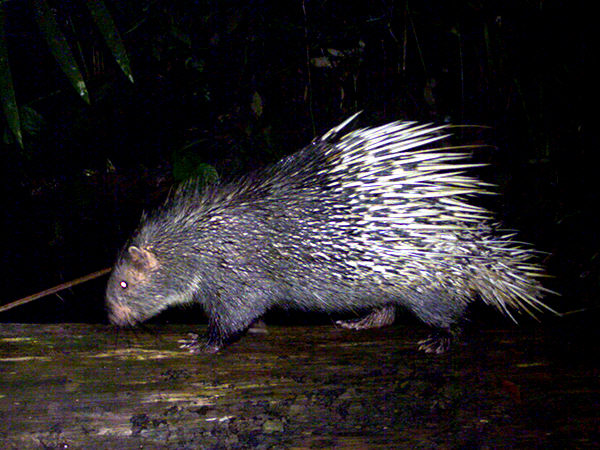
Fig 1

Fig 2

Fig 3

Fig 4

Fig 5

Fig 6
|
Order : RODENTIA
Family : Hystricidae
Species : Hystrix brachyura
Head-Body Length : Up to
72 cm
Tail Length : Up to 11 cm
The Malayan Porcupine, or East Asian Porcupine, is
one of the largest of Southeast Asia's seven species of porcupine. It
occurs in a wide range of habitats including primary and secondary forest,
cultivated areas and plantations. The species appears to be almost
exclusively nocturnal.
It has a varied diet of fallen fruit, roots, tubers and bark, and may
sometimes scavenge for food scraps at the edge of villages. They have
large incisors and powerful jaws used for crushing seeds and nuts. They
are also known to gnaw on bones, and to take bones back to their burrows.
They inhabit large burrows which are excavated in suitable soils with
their powerful front feet and long claws. These burrows can form extensive
warrens, and may be used for many generations.
Family bonds appear strong: it is common to see groups of 2 to 4
individuals foraging together at night. Up to 10 individuals may live in a
social colony.
The front half of the body is dark brown to near black. The rear half is
equipped with long, sharp quills which are banded black and white, or dark
brown and white. Typically the longer quills are predominantly white, with
a dark band in the middle. Long, thick hairs on the nape may be erected
into a crest. The tail is relatively short, with thick, hollow quills
which can be rattled when the animal feels threatened.
The species is probably only predated by large cats, such as Leopards,
however it must be a hungry predator that attempts to kill a Malayan
Porcupine : when threatened these animals will charge backwards into their
attacker, spines raised.
The Malayan Porcupine occurs in parts of India, Nepal, Bangladesh and
southern China. Within Southeast Asia it is widespread on the mainland,
occurring in Myanmar, Thailand, Vietnam, Cambodia, Laos, Peninsular Malaysia
and Singapore. It also occurs on the islands of Borneo and Sumatra.
Fig 1 : Example from the lowlands of Peninsular Malaysia, at the edge of
secondary forest.
Fig 2 : A pair of Malayan Porcupine explore the edge of a stream gully in Peninsular Malaysia.
Figs 3 and 4 : A fallen tree makes it easy for these porcupines to cross a
muddy stream.
Fig 5 : Rear view with quills raised.
Fig 6 : Example from Cambodia, cared for in an animal rescue centre.
References :
Francis, C.M. 2019. A Field Guide to the Mammals of South-east Asia. Second
Edition. New Holland. 416 pp.
Lekagul, B., McNeely, J., 1977. Mammals of Thailand. Association for the
Conservation of Wildlife, Thailand. 758 pp.
Payne, J., Francis, C.M., 1998. A Field Guide to the Mammals of
Borneo. The Sabah Society
|